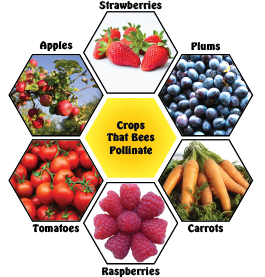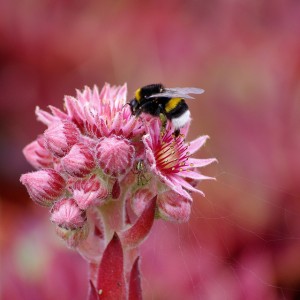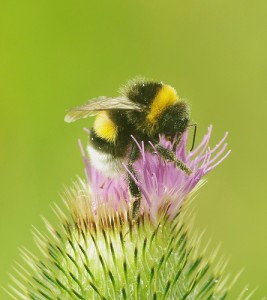
The ‘Let’s Bee friendly’ campaign is, being jointly launched by Wexford Tidy Towns Biodiversity Group supported by Wexford County Council as an action under the Wexford County Biodiversity Action Plan 2013-218, which is aimed at helping safeguard Ireland’s bees and other under-threat pollinators. Through the ‘Let’s Bee friendly’ campaign we are helping schools and public areas such as libraries, parks, community gardens etc. to establish pollinator friendly gardens and wildflower meadows through encouraging the planting of suitable nectar plants to flower for as much of the year as possible.
Keep an eye out for our ‘Let it Bee’ signs around the town. These signs will highlight areas that have plants growing there to encourage bee pollination. Pledge your support to the ‘Let’s Bee Friendly Campaign’ by planting one or more pollinator friendly flowers. For a selection of recommended plants see here.
Bees are the most important pollinating insect because they visit flowers to collect food for their larvae, as well as feeding on floral resources as adults. In Ireland crops such as apples, clover, strawberries and oilseed rape all benefit from pollination and a recent study from the Department of the Environment valued this ‘ecosystem service’ that bees provide at €85m a year to the economy.
2013: Worldwide study shows the decline of wild bees and other pollinators may be an even more alarming threat to crop yields than the loss of honeybees, revealing the irreplaceable contribution of wild insects to global food production.
In Ireland there are 101 species of bee, including the familiar honeybee (One species) and 20 bumblebee species. The remaining species are solitary, meaning they do not form colonies.
Amongst the most well-known services performed by a healthy biodiversity is pollination. Bees are the keystone pollinator species making more flower visits than any other insect. There is a need however for urgent action as our wild bees are facing an unprecedented crisis in declining populations due to agricultural intensification, habitat degradation, disease and parasite spread, and climate change. Pollinators play a crucial role in our farms, gardens and countryside – we cannot afford to take them for granted.
Gardening for Bees
Gardens are extremely important for bees, and vice versa. Bees need flowers for sustenance, and flowers need bees for pollination. But it’s important the flowers you grow provide the food bees need. So Let’s Bee Friendly by turning part of your garden into a bumblebee haven!
- As a rule of thumb your garden should provide bee-friendly flowers, open cup shaped flowers are the bees’ favorites such as foxgloves, that are rich in pollen and nectar which bees can easily access from spring until late summer. This will ensure that there is a good supply of pollen at all of the crucial times.
- Flowers clustered into clumps of one species will attract more pollinators than individual plants scattered through the habitat patch.
- Plants like Pussy Willow and Bluebell are excellent early-year food sources. Mahonia and Hebe are good non-native options
- In early summer Honeysuckle and Thyme are ideal, and in late summer Heathers, Knapweed, Scabious, and non-native species like Sunflowers, Sweet pea and Lavender will provide plenty for bees to forage on.
- If you can, leave an area of your lawn uncut during summer to allow Clovers and Bird’s-foot Trefoil to flower. Leaving uncut verges or planting wildflower meadows will greatly benefit bees.
- Many solitary species nest in south facing banks, so leaving exposed areas of soil at the edges of lawns or creating south facing banks of sandy or clay soil will attract ground nesting species. Other species will nest in dead wood or in south facing stonewalls
Things to Avoid
- Some species have a habit of escaping from gardens and invading wild habitats nearby, for example, rhododendron and Himalayan balsam.
- Certain plants have flower shapes that bumblebees cannot use. For example, some flowers have petals that form long tunnels which are too long or narrow for the bees to feed from. Similarly, flowers with multiple tightly packed heads offer bees very little accessible food.
- Other flowers may not be suitable because they produce little or no pollen and nectar. Plants like pansies and double begonias offer little for bumblebees and other pollinators.
- You should avoid using any pesticides in your garden. They are often labelled as ‘bug killers’ or something similar, but almost all of these can harm Bumble Bees, even if you don’t intend to harm them.
Bee Related Websites and Articles
- Biodiversity Ireland Pollinators Information
- County Wexford Beekeepers
- The Federation of Irish Beekeepers Association
- Councils – All-Ireland Pollinator Plan
- The Plight of the Honeybee
- Build an Insect Hotel
Download – Posters
Download, distribute and print any of our posters to let others know more about the ‘Let’s Bee Friendly’ Campaign and how everyone can help the bees.
List of garden centres taking part in Lets Bee Friendly Campaign
- Beechdale Plantplus Clonroche, Cois Na Abhann Camolin
- D-Plant Horticulture, Enniscorthy, Drinagh Garden Centre Rosslare Road
- Kilcannon Garden Centre, Old Dublin Road
- Springmount, Ballycanew Road, Gorey
- Woodies Clonard Retail Park





